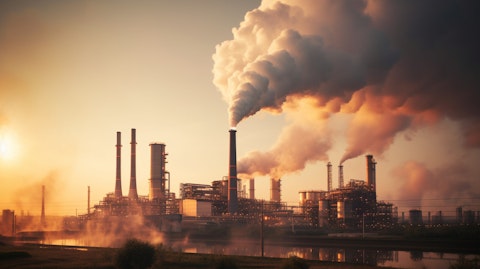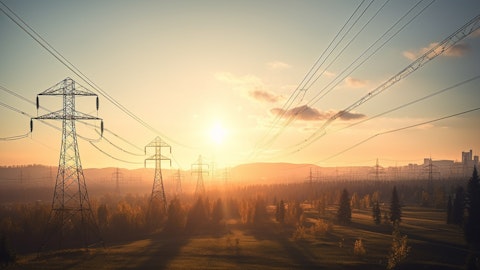In this article, we will look at the 20 least green cities in the US. If you want to skip our detailed analysis, you can go directly to the 5 Least Green Cities in the US.
Emissions in the US
Global carbon dioxide emissions continue to rise at alarming levels. In 2023 alone, the total emissions witnessed an increase of 410 million tonnes reaching a total of 37.4 billion tonnes, driven by extreme droughts, especially in the US and China, the International Energy Agency reported.
READ ALSO: 24 US Cities Most Affected by Climate Change and 20 Most Sustainable Cities in the World.
Fossil fuel remains the biggest contributor to greenhouse gas emissions, accounting for a significant 74.6% of the total GHG emissions from 1990 to 2022. Although there have been substantial developments in energy transition and clean energy adoption, the progress is still lower than the desired levels. A report by McKinsey and Company states that the United States will need to invest a total of $27 trillion through 2040 to deploy climate technologies at scale.
According to the Environment Protection Agency, the primary sources of emissions in the US are fossil fuel-produced electricity, heat, and transportation. In 2022, transportation had the largest share of direct emissions, shortly followed by electricity production. The commercial and residential sectors also recorded a significant increase in their total emissions, after initially appearing to have lower emissions. Other sectors such as agriculture and forestry also contribute to emissions. However, forests can act as a carbon sink offsetting 13% of total gross emissions.
Emissions in the country witnessed a sharp decline due to the COVID-19 pandemic in 2020. However, it rebounded later in 2022 due to an increase of 8% in carbon dioxide emissions from fossil fuels, compared to 2020 levels. Natural gas consumption also increased by 5% while coal fell by 6%.
Despite the increase in conventional energy emissions, the US has made noteworthy efforts to combat emissions and climate change in the country from regulations like corporate average fuel economy, energy transition, and participation in international agreements. The United States has been increasingly proactive in implementing emissions regulation. A recent instance is the penalty of $145.8 million imposed on General Motors for exceeding the emissions limit. This will require the automaker to forfeit millions of dollars in carbon credits, exhibiting the US government’s commitment to combating climate change through the enforcement of regulations and holding industries accountable for their carbon footprint. However, the future of these regulations might change with respect to the election outcomes.
Growing Renewable Energy Sector
According to the International Renewable Energy Agency, nearly 473 gigawatts of capacity was added in 2023, up 14% from the year before and the highest since 2000. The minimum rate to reach the 11 terawatts target by 2030 is 16.4%. If the world continues to grow renewable capacity at the same rate as last year the target will still be 1.5 terawatts short. The historic growth rate of 10% will only result in a renewable capacity of 7.5 terawatts by 2030.
UBS analysts predict that renewable energy can meet 70% of the growing electricity demand in the United States by 2030 with solar and wind accounting for the majority share of its generating capacity. This could drive significant investment in renewable energy infrastructure.
On July 16, the CEO and president of the utility company AES, Andrés Gluski appeared on CNBC where he expressed optimism about the future of renewable energy in the US. Gluski believes that renewable energy is set for unprecedented growth irrespective of who wins the election. The CEO believes that while government subsidies play a role, what truly drives the growth of renewables is investment and production tax credits. Moreover, data centers are going to drive the demand for renewables in the United States. Gluski also noted the need for energy storage and policy changes to support clean energy transition in the country. He said that the reindustrialization of America and clean energy go hand in hand.
Gluski believes that the demand for renewable energy is expected to grow. He said:
“AI is making the demand for energy growth in the U.S. again. Total demand from the systems is growing at 4%. For many years, the demand for electricity was flat. So the only way that the demand does not grow is if the AI revolution stops.’
Nextracker Inc. (NASDAQ:NXT) is a top US company in solar technology. The renewable energy company provides curated solar trackers and software that utilize advanced technology to optimize energy production by solar panels. Its tracking system analyzes and tracks the movement and orientation of the sun, improving the overall yield of solar panels.
Nextracker Inc. (NASDAQ:NXT) is continuously expanding its manufacturing footprint. It recently launched a 160,000-square-foot facility in Nevada aimed to produce steel torque tubes that hold and rotate panels in solar power plants. This is the second factory launched by the company over the past year. It will support the generation of 2 gigawatts of solar power annually, enough to power 200,000 homes in the US.
The solar tracking company recorded a strong first quarter of the fiscal year 2025, recording double-digit year-over-year revenue growth. Its key solar tracking products are NX Horizon, NX Gemini, and NX Horizon-XTR. The introduction of two new products agri PV and NX low carbon tracker will further strengthen its market position.
Nextracker Inc. (NASDAQ:NXT) also recently acquired Ojjo and Solar Pile International to expand its utility-scale solar tracker business. This move by the company makes it a one-stop shop for solar developers and operators. With a strong backlog of over $4 billion, Nextracker Inc. (NASDAQ:NXT) emerges as one of the top renewable companies in the United States.
While we acknowledge the potential of NXT as an investment, our conviction lies in the belief that some AI stocks hold greater promise for delivering higher returns, and doing so within a shorter time frame. If you are looking for an AI stock that is more promising than NVDA but that trades at less than 5 times its earnings, check out our report about the cheapest AI stock.
Now, let’s have a look at the 20 least green cities in the US.

An industrial plant with an array of thermal oxidizers to reduce air emissions.
Methodology
To compile our list of the 20 least green cities in the US, we used emissions data of states from the International Energy Agency, as our proxy, and ranked the biggest city in each of the top 20 states with the highest emissions on our list. Our list ranks the 20 least green cities in the US in ascending order of carbon emission of their states.
Note: The data has not been adjusted for cities.
At Insider Monkey we are obsessed with the stocks that hedge funds pile into. The reason is simple: our research has shown that we can outperform the market by imitating the top stock picks of the best hedge funds. Our quarterly newsletter’s strategy selects 14 small-cap and large-cap stocks every quarter and has returned 275% since May 2014, beating its benchmark by 150 percentage points (see more details here)
20 Least Green Cities in the US
20. Charleston, West Virginia
Carbon Dioxide Emissions (2021): 88.4 million metric tons
Charleston is ranked 20th on our list of the least green cities in the United States. In 2021, the city made a commitment to reduce emissions by 56% by 2030 and reach net zero by 2050. It is the largest city in West Virginia which emitted 88.4 million metric tons of carbon dioxide emissions in 2021.
19. Newark, New Jersey
Carbon Dioxide Emissions (2021): 89.1 million metric tons
Newark is ranked 19th on our list. According to Environment New Jersey, the number of days in Newark with high temperatures above 90ºF could quadruple by 2050, leading to five times more heat-related deaths. The state of New Jersey reached 89.1 million metric tons of carbon dioxide emissions in 2021.
18. Milwaukee, Wisconsin
Carbon Dioxide Emissions (2021): 92.5 million metric tons
Milwaukee is one of the least green cities in the US. It aims to reduce its GHG emissions by at least 45% by 2030. Wisconsin has warmed by 2ºF to 3ºF since 1950. It is projected to have a higher temperature with a projected 2ºF to 8ºF increase by 2050. In 2021, the state emitted 92.5 million metric tons of carbon dioxide emissions.
17. Nashville, Tennessee
Carbon Dioxide Emissions (2021): 92.7 million metric tons
Nashville is committed to reducing GHG emissions by 80% by 2050 compared to 2014 levels. Moreover, it also passed a resolution to achieve a 50% reduction in food waste by 2030. It is ranked 17th on our list.
16. Virginia Beach, Virginia
Carbon Dioxide Emissions (2021): 98 million metric tons
Virginia Beach is ranked 14th on our list of the least green cities in the United States. Its state, Virginia emitted 98 million metric tons of carbon dioxide emissions in 2021.
15. Huntsville, Alabama
Carbon Dioxide Emissions (2021): 108.4 million metric tons
Next up on our list is Huntsville, the biggest city in Alabama. In 2021, the state generated 108.4 million metric tons of carbon dioxide emissions.
14. Louisville, Kentucky
Carbon Dioxide Emissions (2021): 111.3 million metric tons
Louisville plans to reach 80% reduction in carbon dioxide emissions by 2050. The state of Kentucky emitted 111.3 million metric tons of carbon dioxide emissions in 2021.
13. Charlotte, North Carolina
Carbon Dioxide Emissions (2021): 115.6 million metric tons
Charlotte aims to reach 100% carbon neutrality in fuel required for city fleets and facilities by 2030 and become a low-carbon city by 2050 by reducing GHG emissions to 2 tonnes/person annually. It is ranked 13th on our list.
12. Kansas City, Missouri
Carbon Dioxide Emissions (2021): 117.0 million metric tons
Kansas City is the 12th least green city in the United States. The city faces climate change consequences such as increased temperatures, heightened drought periods, and frequent flooding. Its state, Missouri is also among the largest carbon-emitting states.
11. Atlanta, Georgia
Carbon Dioxide Emissions (2021): 124.1 million metric tons
Commercial emissions and transportation contribute the highest to Atlanta’s overall emissions. It has taken multiple initiatives to reduce its emissions. Among them, its walkable cities initiative is a prominent one aiming to encourage communities to reduce vehicle miles traveled.
10. Detroit, Michigan
Carbon Dioxide Emissions (2021): 147.8 million metric tons
Buildings are the largest source of emissions in Detroit, representing 63% of its total greenhouse gas emissions in 2018. In 2023, it developed a new policy requiring municipal buildings, commercial, and multi-family buildings over 100,000 gross square feet to report their energy and water consumption annually. This will also apply to building over 25,000 GSF to report their energy and water usage in 2025. Detroit is ranked 10th on our list of the least green cities in the United States.
9. New York, New York
Carbon Dioxide Emissions (2021): 156.0 million metric tons
New York City committed to reduce its greenhouse gas emissions by 80% by 2050. Its emissions are mainly driven by buildings, transportation, and waste. Buildings contribute to the vast majority of its emissions as they rely on fossil fuels for heating, cooling, and other applications. The city passed a regulation in 2019 requiring buildings over 25,000 square feet to reduce their emissions by using clean energy technologies, with the mission to reduce building emissions by 40% by 2030. New York City is ranked 9th on our list.
8. Indianapolis, Indiana
Carbon Dioxide Emissions (2021): 166.4 million metric tons
Indianapolis is ranked 8th on our list of the least green cities in the US. The city aims to achieve carbon neutrality by 2050. It also committed to an interim target of reaching a 62.8% reduction in per capita emissions by 2030.
7. Chicago, Illinois
Carbon Dioxide Emissions (2021): 184.2 million metric tons
Chicago has set a goal of reaching an 80% reduction in carbon dioxide emissions by 2050, compared to 1990 levels. 91% of its emissions come from electricity, natural gas, and transportation. If Chicago continues its emissions at current levels, it will experience a 35% increase in emissions levels by 2050 compared to 2000, The Center for Neighborhood Technology reported. Air pollution is also a major issue in the city leading to increased chronic illnesses.
6. New Orleans, Louisiana
Carbon Dioxide Emissions (2021): 188.6 million metric tons
New Orleans is greatly impacted by climate change which is evident by its water-related vulnerabilities including sea level rise, tornadoes, and flooding. Its low elevation also contributes to these issues. Over 51% of its emissions come from the energy sector. The city aims to reach carbon neutrality by 2050.
5. Columbus, Ohio
Carbon Dioxide Emissions (2021): 194 million metric tons
Columbus is ranked 5th on our list of the least green cities in the US. It has set a goal to reach carbon neutrality and 100% renewable electricity by 2050. Its interim goal is a 45% reduction in its 2013 emission levels by 2030. It also aims to reduce energy use by 10% in commercial, industrial, and residential sectors by 2030.
4. Philadelphia, Pennsylvania
Carbon Dioxide Emissions (2021): 213.5 million metric tons
Philadelphia is the 4th least green city in the United States. It aims to reduce its emissions by 28% in 2025, compared to 2006 levels. It also aims to reduce energy use by 20% by 2030.
3. Jacksonville, Florida
Carbon Dioxide Emissions (2021): 226.3 million metric tons
Jacksonville is ranked 3rd on our list of the least green cities in the United States. Its biggest source of GHG emissions is the Jacksonville Electric Authority, which accounts for over 90% of the regional emissions.
2. Los Angeles, California
Carbon Dioxide Emissions (2021): 324 million metric tons
Transportation is one of the biggest sources of emissions in Los Angeles. The city has witnessed a tremendous decrease in its emissions over the past few years, however, it requires more efforts to reduce its emissions. It aims to reach a 73% reduction in greenhouse gas emissions by 2035, compared to 1990 levels.
1. Houston, Texas
Carbon Dioxide Emissions (2021): 663.5 million metric tons
Houston is ranked 1st on our list of the least green cities in the US. The city aims to reduce its greenhouse gas emissions by 80% by 2050, compared to the 2005 baseline.
READ NEXT: $30 Trillion Opportunity: 15 Best Humanoid Robot Stocks to Buy According to Morgan Stanley and Jim Cramer Says NVIDIA ‘Has Become A Wasteland’
Disclosure: None. This article was originally published at Insider Monkey.





